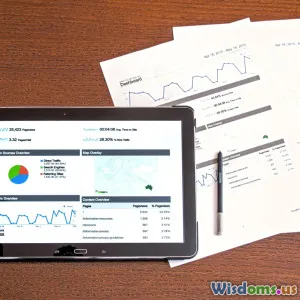
Secrets of Effective Risk Management Stories from Industry Leaders
33 min read Real-world lessons on effective risk management from industry leaders, revealing frameworks, metrics, and culture shifts that transform uncertainty into strategic advantage. (0 Reviews)
Risk does not knock politely. It sneaks in through supplier tiers you have never mapped, slips through code paths no one thought to test, and compounds silently when incentives punish candor. Yet when risk management is done well, there is little drama; only quiet resilience that looks like common sense in hindsight. This article distills practical secrets from industry leaders who learned, sometimes the hard way, how to make risk a source of confidence rather than fear.
Secret 1: Start with risk appetite, then work backward

The most effective programs begin by translating strategy into explicit statements of risk appetite. Without it, teams either overreact to noise or miss the signal entirely.
What it looks like in practice
- A board-approved risk appetite statement that defines how much risk the organization is willing to accept in pursuit of its goals, broken down by category: financial, operational, cyber, compliance, safety, and reputation.
- Clear metrics and limits tied to that appetite, with escalation paths when thresholds are exceeded.
- Decision rules that align with appetite. For example, a fintech might accept higher fraud risk for a new market entry but only within a quantified loss envelope and with automatic rollback criteria.
Leader example: Shell’s scenario planning Starting in the 1970s, Shell institutionalized scenario planning to align strategy with risk appetite. That discipline helped Shell adjust faster to the 1973 oil shock than many peers, not because it predicted the exact event, but because leaders had agreed in advance on which uncertainties would trigger what strategic responses. The secret here is not prediction; it is pre-commitment to action.
How to write a one-page risk appetite memo in 45 minutes
- Define value at risk: top five sources that could derail the strategy in the next 12–24 months.
- Set guardrails: for each source, specify a maximum tolerable loss, downtime, or variance.
- Map leading indicators: a small set of early signals for each risk (for example, supplier late-delivery rate exceeding 5 percent for two consecutive weeks).
- Decide escalation points: who gets the call, in what timeframe, with authority to act.
- Publish the memo company-wide, and revisit quarterly.
Secret 2: Quantify what matters, not everything

Great risk leaders are disciplined about quantification. They do not boil the ocean; they model material risks, define uncertainty, and make choices under bounded confidence.
Techniques that work
- Monte Carlo simulation to capture ranges and probabilities for project timelines or financial outcomes.
- FAIR for cyber risk quantification, a method that expresses risk in financial terms by modeling frequency and magnitude of loss. Open FAIR has emerged as a recognizable standard, allowing leaders to compare initiatives on a common denominator.
- Bowtie analysis to visualize the causal path from threats to consequences, and to identify preventive and mitigative controls.
Mini case: Quantifying fraud risk at a payments startup A payments startup estimated annual gross fraud loss at 0.35 percent of volume with a wide variance. By combining FAIR with historical incident data and merchant segmentation, leaders modeled a 90 percent confidence interval for loss between 0.25 and 0.45 percent. That single step enabled a better investment tradeoff: spending 6 million on machine learning improvements to reduce the loss band to 0.20–0.28 percent, yielding an expected net benefit exceeding 10 million.
Checklist for pragmatic quantification
- Start with base rates, not anecdotes.
- Use ranges; avoid point estimates.
- Make assumptions explicit on a single page.
- Link outputs to decisions: invest, accept, avoid, or transfer.
- Track forecast accuracy for learning over time.
Secret 3: Rehearse failure until it gets boring

Netflix popularized chaos engineering in 2011 with its Simian Army tools like Chaos Monkey, which intentionally break components in production to test resilience. The insight is simple: you will fight the way you train.
What leaders do
- Schedule regular game days and tabletop exercises that simulate realistic pressure, including uncertain information, cross-functional dependencies, and escalating media or customer inquiries.
- Incorporate injects that test assumptions, like an unavailable vendor, a key person on vacation, or a conflicting priority from a major customer.
- Measure learning, not just uptime: time to detect, time to mobilize, time to decide, time to recover, and the quality of cross-functional handoffs.
Google’s DiRT exercises Google runs Disaster Recovery Testing exercises to rehearse how systems and people respond to disruption. The lesson is to treat resilience as a muscle that atrophies without practice. Even basic runbooks drift from reality unless tested.
Host an effective 90-minute tabletop
- Scenario: ransomware encrypts a shared file system containing invoices and support attachments.
- Objectives: confirm roles, communication cadence, and decision authority.
- Roles: incident commander, technical lead, communications lead, legal, customer success, finance.
- Timeline: 0–15 minutes signal detection; 15–45 containment decisions; 45–60 external notification drafting; 60–90 decision on service degradation and customer messaging.
- Debrief: five improvements due within two weeks.
Secret 4: Push authority to the edges, safely

The aviation industry taught the world that safe operations require distributed authority. Crew Resource Management, pioneered in the late 1970s after NASA research, trained crews to speak up, challenge, and share situational awareness, leading to dramatic safety improvements industry-wide.
Lessons applied beyond the cockpit
- Safety comes from voice, not hierarchy. Encourage dissent by design, especially under uncertainty.
- Use explicit trigger conditions for frontline authority. For example, allow any engineer to abort a deployment if error rates exceed a defined threshold.
- Train for assertive communication. Techniques like SBAR in healthcare (Situation, Background, Assessment, Recommendation) reduce ambiguity in high-stress handoffs.
Manufacturing example Toyota’s andon cord embodies this principle: any worker can stop the line at the first sign of quality risk. That cultural norm, when adapted thoughtfully to digital operations, results in faster detection and lower blast radius for defects.
Build it into policy
- Define authority matrices in plain language.
- Document not only who can say yes, but who can say stop.
- Reward the right calls even when they are false alarms.
Secret 5: Map dependencies before they map you

Hidden interdependencies are where small failures become big ones. Leaders make their systems and supply chains legible.
Toyota’s multi-tier mapping after the 2011 earthquake Following the Tohoku earthquake, Toyota created a comprehensive global database that mapped more than 400,000 parts and thousands of suppliers across multiple tiers. By knowing where critical components lived, the company could reroute, substitute, or prioritize, responding faster to later disruptions such as the Kumamoto earthquakes. The insight: you cannot reroute what you cannot see.
Tools that help
- Bowtie for causal paths and control placement.
- HAZOP and FMEA for process and design risks in manufacturing and healthcare.
- Service maps for tech stacks that trace dependencies between microservices, data stores, third-party APIs, and identity providers.
How to start a dependency map in two weeks
- Inventory: gather existing architecture diagrams, supplier contracts, and process maps.
- Identify criticals: the 20 percent of components supporting 80 percent of value or safety.
- Trace upstream: for each critical, identify direct and one additional tier of suppliers or system calls.
- Add fragility markers: single points of failure, concentration risk, long lead times, manual processes.
- Validate in workshops with the people who actually run the systems.
Secret 6: Decide at the right speed

Not all decisions carry the same risk. Amazon popularized the distinction between one-way-door decisions that are hard to reverse and two-way-door decisions that can be rolled back. The best risk leaders formalize this logic using technical and business guardrails.
Google SRE error budgets Service Level Objectives are deliberate tradeoffs between reliability and velocity. If the SLO is 99.9 percent availability, the monthly error budget is about 43.2 minutes of allowable downtime. At 99.99 percent, the budget shrinks to roughly 4.32 minutes. Teams can push change rapidly until the budget is consumed, then must slow down to stabilize. This makes risk appetite operational: shipping faster is acceptable until it meaningfully jeopardizes reliability.
Practical playbook
- Classify decisions by reversibility and blast radius.
- Pre-approve patterns for two-way-door changes with lightweight reviews.
- Require additional peer review and risk sign-off for one-way-door bets.
- Use error budgets and rollback plans to manage pace rather than relying on heroics.
Secret 7: Hedge what you cannot control

Some risk can be mitigated; some must be priced and transferred. Leaders know their exposures and use markets intelligently.
Southwest Airlines and fuel hedging For years leading up to 2008, Southwest hedged a significant portion of its jet fuel needs. Analysts have estimated that these hedges saved the airline billions relative to unhedged peers when oil prices spiked, with figures often cited around 3.5 billion over a decade. This was not luck; it was a clear policy aligned to fuel price risk appetite and the company’s low-fare strategy.
Risk transfer beyond commodities
- Parametric insurance that pays based on measured indices such as wind speed or rainfall to protect against weather-driven revenue shocks.
- Reinsurance or captives for tail events.
- Cloud capacity reservations to stabilize compute costs in fast-growing tech companies, paired with architecture that can shift regions or providers if needed.
Hedging checklist
- Know your basis risk. Make sure the hedge actually tracks your exposure.
- Set limits on hedge ratios and maturities.
- Avoid speculative positions; the goal is smoothing, not betting.
- Integrate hedging into budgeting so leaders are not surprised by accounting effects.
Secret 8: Build early warning with leading indicators

Lagging metrics tell you what happened. Leading indicators tell you what might happen soon enough to adjust.
Design better Key Risk Indicators
- Tie each KRI to a risk appetite statement. If you cannot say which appetite it reflects, it is noise.
- Focus on small sets per risk category, typically three to five.
- Make thresholds and playbooks explicit: what happens at yellow, orange, and red levels.
Examples that work in practice
- Supplier stability: share of suppliers with on-time delivery below 95 percent for two consecutive periods.
- Operational resilience: queue depth trends in customer support that forecast churn risk.
- Cyber posture: percentage of critical systems with unpatched high-severity vulnerabilities beyond service-level agreements.
- Liquidity: daily cash buffer relative to 30-day stressed outflows.
Rule of thumb KRIs should trigger decisions, not debates. If the indicator turns red and nothing happens, it is the wrong indicator or the wrong threshold.
Secret 9: Communicate under pressure like a pro

When the stakes are high, communication is risk control. It can preserve trust, avoid legal pitfalls, and align teams.
Johnson and Johnson’s Tylenol recall In 1982, tampering led to seven deaths linked to cyanide-laced Tylenol in the Chicago area. Johnson and Johnson recalled an estimated 31 million bottles, halted production, cooperated fully with authorities, and introduced tamper-resistant packaging. The company’s transparency and speed are widely credited with helping it regain consumer trust and market share. The lesson: tell the truth fast, put safety first, and over-communicate.
Crisis communication playbook
- First hour: acknowledge, express empathy, and share what is known and unknown; commit to updates at a set cadence.
- Single source of truth: one page updated live for employees, customers, and partners.
- Pre-approved templates: drafts for regulators, customers, investors, and the press that can be tailored rapidly.
- Spokesperson prep: message maps with three core points and anticipated tough questions.
- After-action: capture communication wins and gaps as part of the postmortem.
Secret 10: Turn incidents into assets

Incidents are tuition. Leaders ensure the organization gets full value from what it already paid for.
Maersk and NotPetya In 2017, Maersk was hit by the NotPetya malware, incurring an estimated 300 million in costs. The company famously reinstalled roughly 45,000 PCs and 4,000 servers in about 10 days. Maersk’s post-incident investments emphasized segmentation, immutable backups, and global coordination, and it became a vocal advocate for raising industry-wide cyber hygiene. The secret here is speed of learning: document gaps, assign owners, fund the fixes, and verify completion.
Make learning systematic
- Blameless postmortems that focus on system conditions, not individual fault.
- Action item hygiene: few, prioritized, with clear owners and deadlines.
- Verification: automated checks that prevent regressions, such as policy-as-code and continuous compliance.
- Quarterly learning reports to the board: top themes, mitigations implemented, and residual risk.
Frameworks that help
- NIST Cybersecurity Framework to structure identify, protect, detect, respond, and recover activities.
- Secure Development Lifecycle practices, popularized at Microsoft, to shift security earlier in design and reduce critical vulnerabilities over time.
Secret 11: Create optionality with scenario planning

The goal of scenario planning is not to be right; it is to be ready. When leaders consider a small set of plausible futures, they discover low-cost options that perform well across scenarios.
Shell’s enduring lesson Shell’s planning discipline has long emphasized narratives about the future that include social, political, and technological forces. By stress-testing strategy against these narratives, leaders avoided binary bets and instead built flexibility.
Real options in operations
- Dual sourcing for critical components with pre-negotiated volume bands.
- Modular architectures that allow partial degradation rather than full outage when a dependency fails.
- Workforce cross-training to maintain delivery under localized disruptions.
Run a scenario workshop
- Pick two pivotal uncertainties that matter most, such as regulatory tightening vs. loosening and supply chain concentration vs. diversification.
- Build four scenarios around the extremes with concrete stories.
- Identify no-regret moves that make sense in all scenarios, and targeted options worth a small premium in specific scenarios.
- Set trigger points and monitoring for each scenario.
Secret 12: Measure resilience, not just prevention

Prevention matters, but perfect prevention is fantasy. Resilience metrics tell you how well you absorb and recover.
Metrics that move the needle
- Mean time to detect and mean time to recover. Track median and tail behavior; the 95th percentile often reflects real customer pain.
- Time to mobilize: minutes from detection to having the right people in the room, virtually or physically.
- Service degradation budgets: allowable performance drop measured in latency or throughput, aligned with customer tolerance.
- Data recovery point objectives and recovery time objectives validated through test restores, not just paperwork.
Concrete example A SaaS company set a 99.9 percent SLO for its API and moved from monthly to weekly chaos experiments. Over two quarters, median time to recover dropped from 28 minutes to 9, and the variance tightened significantly. Incident volume did not decrease, but customer churn did, because disruptions were shorter and better communicated.
How to add resilience without slowing the business
- Design for graceful degradation: read-only modes, cached defaults, and feature flags.
- Invest in observability that pinpoints cause within minutes.
- Build paved roads so teams adopt resilient patterns by default.
Secret 13: Governance that accelerates, not suffocates

The right governance feels light in calm weather and decisive in storms. The wrong governance floods teams with checklists and meetings that do not change outcomes.
Principles that work
- Align to the three lines model. Business owns risk, risk functions challenge and guide, audit verifies.
- Fewer committees, clearer charters. Give the risk committee authority to make decisions within defined limits, and ensure representation from finance, operations, technology, and compliance.
- Risk acceptance as a formal choice. Document who accepted residual risk, for how long, and what would cause a revisit.
- Time-box reviews. Many firms cut change approval lead time by replacing serial reviews with parallel, risk-based checks.
A bank’s practical reform One regional bank reduced product approval time from 45 days to 10 by adopting concurrent reviews and standardized templates for common risk profiles. Escalations were reserved for truly novel risks, freeing senior leaders to focus where it mattered. The key was to codify patterns and trust teams to use them.
Secret 14: Ethics and reputation are risk multipliers

Ethical lapses multiply other risks. Data privacy, safety, and integrity issues quickly become legal, financial, and brand crises.
What leading firms do
- Privacy by design: minimize data collection, apply strong access controls, and build deletion as a feature, not an afterthought.
- Transparent AI use: model cards, bias testing, and explainability for high-stakes decisions.
- Supplier standards: code of conduct audits, whistleblower protection, and remediation plans.
Why it matters Trust compresses recovery time. Stakeholders give the benefit of the doubt to organizations with a track record of responsibility. That window is strategic oxygen during a crisis.
Secret 15: The CRO mindset for every executive

In high-performing companies, every CXO behaves like a chief risk officer for their domain. Finance focuses on liquidity and covenant resilience, operations on continuity and safety, technology on resiliency and security, and HR on talent and culture risks. The trick is coherence.
Create a cross-functional rhythm
- Monthly risk council that reviews KRIs, scenario signals, and top incidents.
- A single enterprise risk register that links to team backlogs and budgets.
- Quarterly deep dives rotating across topics: cyber, third-party risk, regulatory change, climate and physical risk.
Link money to risk Budget line items to risk reduction outcomes. For example, tie a cloud reliability investment to a quantified decrease in downtime cost and an improvement in customer retention. The finance team becomes a partner in resilience, not a gatekeeper.
Secret 16: Put structure around third‑party risk

Vendors extend your capability and your attack surface. Leaders treat third parties like internal systems: with standards, testing, and contingency plans.
Practical steps
- Tier vendors by criticality and data sensitivity. High-critical vendors get deeper due diligence and monitoring.
- Use standardized questionnaires grounded in recognized frameworks, but verify with evidence: SOC 2 reports, penetration test summaries, patch management metrics.
- Contract for visibility and response: right to audit, 24-hour incident notification, participation in joint exercises.
- Playbooks for rapid replacement of critical vendors, including pre-vetted alternates and data-export procedures.
Example A healthcare provider integrated a vendor’s cloud EHR system into its tabletop exercises. When a simulated outage occurred, the provider switched to read-only backups and paper intake within 45 minutes, keeping patient flow stable while the vendor restored service. The lesson: practice the interfaces, not just the components.
Secret 17: Design incentives that surface bad news early

Most risk failures are information failures. People see weak signals but choose silence because the system penalizes messengers.
Design better incentives
- Tie manager bonuses partly to the quality and timeliness of risk escalation, not just outcomes.
- Celebrate near-miss reporting in all-hands meetings.
- Rotate leaders through incident commander roles to build empathy for responders and reduce blame culture.
- Publicly close the loop on reported issues so employees see that raising concerns leads to action.
Borrow from healthcare Many hospitals adopted structured near-miss reporting after safety movements in patient care. Units that actively report near misses often have better safety outcomes because they uncover and fix latent hazards before harm occurs. The same dynamic applies in software, logistics, and finance.
Secret 18: Build cyber resilience for the messy middle

Perfect perimeter security is gone. Leaders assume breach and design for limited blast radius and fast restoration.
Control themes from industry leaders
- Zero trust principles: authenticate and authorize every request, minimize implicit trust based on network location.
- Identity hygiene: strong multi-factor authentication, privileged access management, and rapid credential revocation.
- Segmentation: separate critical systems and management planes; do not allow flat networks.
- Immutable, offline backups: test restores quarterly; treat backups as part of production.
- Detection and response: 24x7 monitoring, rehearsed containment playbooks, and clear thresholds for isolating systems.
Quantify cyber like a business risk Use FAIR to translate ransomware risk into expected annualized loss, then prioritize controls based on expected loss reduction per dollar invested. This frames security spending as capital allocation rather than fear-driven expense.
Secret 19: Translate climate and physical risks into operations

Climate is a risk amplifier. Leaders treat it as an operational and financial factor, not just a sustainability report section.
What good looks like
- TCFD-style disclosures that link scenario analysis to strategy and capital planning.
- Site-level hazard maps for flood, heat, wildfire, and storm, with hardening plans and relocation options.
- Supplier climate risk screening to avoid concentration in high-hazard zones.
- Parametric insurance and business continuity plans aligned to regional hazards.
Example A logistics company mapped distribution centers against flood risk and installed raised electrical systems and flood barriers at two high-risk sites. It also negotiated contingencies with regional carriers to reroute volumes within 24 hours. These investments paid off during a major storm season, maintaining service levels while competitors suffered multi-day delays.
Secret 20: Use simple artifacts that scale

Risk management scales through artifacts that teams actually use.
Artifacts worth adopting
- One-page risk appetite memo per business line.
- Standard risk register with fields for cause, event, consequence, controls, owner, KRI, and review date.
- Playbooks with decision trees for top scenarios, written in plain language.
- Pre-mortem templates based on Gary Klein’s approach: imagine the project failed and write the postmortem in advance.
- Checklists for go or no-go on releases, vendor onboarding, and crisis escalation.
Quality check for any artifact
- It fits on one or two pages.
- It includes a who, when, and what triggers action.
- Teams can update it without a committee.
Practical cadence for all the above
- Weekly: KRI review by team leads with quick adjustments.
- Monthly: risk council across functions.
- Quarterly: scenario refresh and top-5 risk deep dive with the board.
- Annually: full program tune-up and external benchmarking.
Closing thoughts
Risk management shines when it is woven into how a company makes decisions, not when it is stapled on as a compliance exercise. The leaders highlighted here did not eliminate uncertainty; they built capability to face it with clarity, rehearsed action, and the humility to learn. Whether you are running a production line, a payment network, or a global supply chain, the playbook is consistent: declare your appetite, map what matters, quantify within reason, rehearse failure, and keep the voice of ethics and customers at the center. Do that, and risk becomes a source of strategic advantage rather than a tax on ambition.
Security Risk Management Business Strategy Governance Governance, Risk, and Compliance (GRC) Crisis Management Case Studies Scenario Planning Leadership & Culture Compliance & Governance enterprise risk management risk appetite risk culture key risk indicators operational resilience third-party risk
Rate the Post
User Reviews
Other posts in Business Strategy
Popular Posts

















